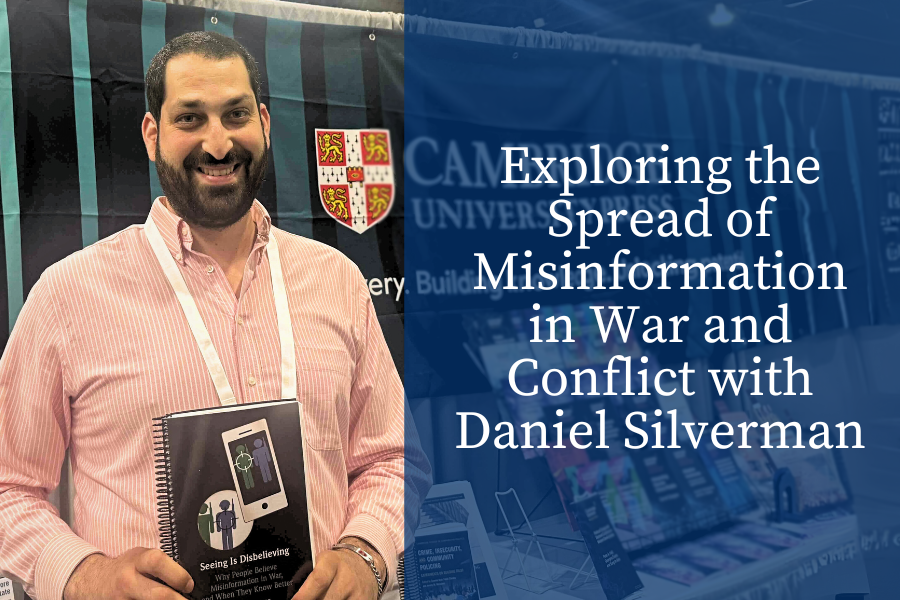
Exploring the Spread of Misinformation in War and Conflict with Daniel Silverman
By Lindsay Marcellus
With over half of adults worldwide now consuming news via social media platforms, inaccurate information can reach thousands of people within minutes, affecting everything from public health to elections to our understanding of current events. In his new book, Seeing Is Disbelieving: Why People Believe Misinformation in War, and When They Know Better, Carnegie Mellon Institute for Strategy and Technology (CMIST) assistant professor Daniel Silverman extends the study of factual misinformation, conspiracy theories, and fake news into a new, high-stakes domain: conflict zones.
The impact of misinformation depends on the extent to which it is believed, and one of the key questions Silverman tackles is what factors contribute to people believing the lies they encounter in war zones. Ever since noticing that debates about US drone strikes in Pakistan were characterized not just by variation in policy recommendations, but also by disagreements over what was happening, Silverman has had a sustained interest in perceptions of wartime violence. As a scholar whose research focuses on international security, political psychology, and the politics of the Middle East, Silverman is particularly interested in how psychological factors, such as biases and misperceptions, not only drive conflicts, but can be leveraged to promote peace.
So, who believes misinformation in war and who is more likely to see through the lies? By pairing survey data with case studies in Pakistan, Iraq, and Syria, Silverman came to a surprising conclusion: People’s false beliefs during war depend on their exposure and proximity to the relevant events. As summarized early on in the text, “The punchline [of the book] is that lies are pervasive in conflict, but they can be punctured when people are close to the ‘action’ over time—in short, that seeing is the key to disbelieving in war.” (1)
Being able to identify where the threat of misinformation is highest has implications for policy. For example, Silverman’s research pushes readers to grapple with whether we can amplify the volume of local frontline voices in conflict zones—relative to those thousands of miles away—in order to curb the reach of lies during modern-day conflicts.
Since joining Carnegie Mellon University in 2017, Silverman has regularly taught courses on the politics of fake news and misinformation and war and peace in the contemporary Middle East. This fall, he will teach a course on the politics of antisemitism. His teaching reflects his commitment to helping students develop a nuanced understanding of complex political issues by creating bridges between what they learn in class and real-world situations.
In addition to his research on misinformation in war zones, Silverman has published a database on how the personal backgrounds of rebel leaders influence the outcomes of civil wars, as well as articles examining the drivers of foreign state support for rebel organizations and what influences civilian beliefs about violent events. His research appears in the Journal of Peace Research, Journal of Conflict Resolution, International Studies Quarterly, International Organization, and more. His new book builds on the study of misinformation, disinformation, and fake news to understand the impact these have on modern armed conflicts, providing the insight needed to draw practical lessons for combating misinformation and promoting peace.
The book, he hopes, “has something to offer to anyone who is interested in the dynamics of truth and falsehood in violent conflicts (and beyond)—and perhaps the beginnings of a framework for those who would like to cultivate more truth.” (2)
Those interested in misinformation, its implications for warfare and security, and how to effectively counter it are invited to join CMIST on Tuesday, March 18, for a book launch event celebrating the release of Seeing is Disbelieving and its contribution to better understanding false beliefs and their impact on modern armed conflicts.
(1) Daniel Silverman, Seeing Is Disbelieving: Why People Believe Misinformation in War, and When They Know Better (Cambridge University Press, 2024), 16.
(2) Silverman, Seeing Is Disbelieving: Why People Believe Misinformation in War, and When They Know Better, 17.
